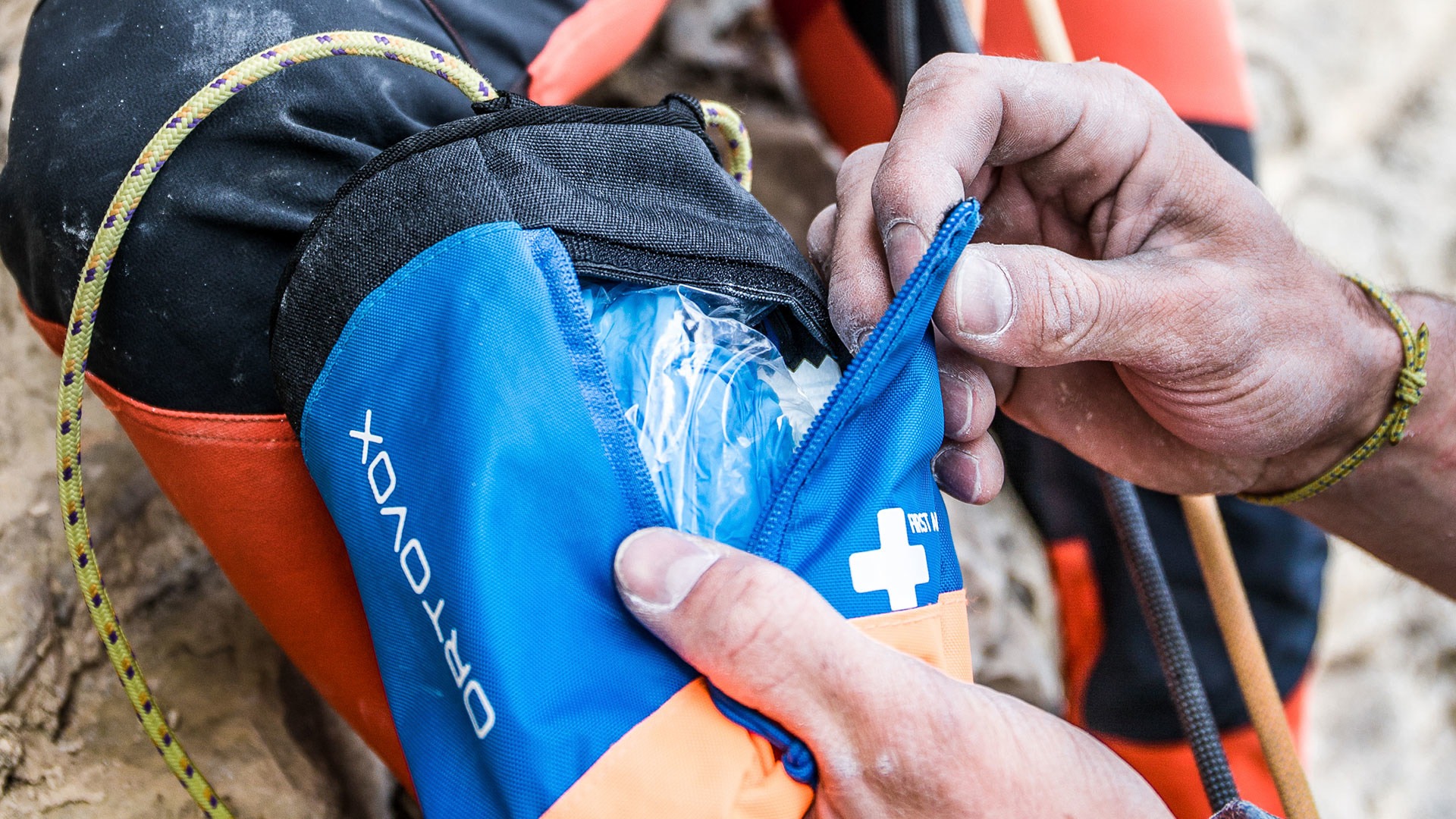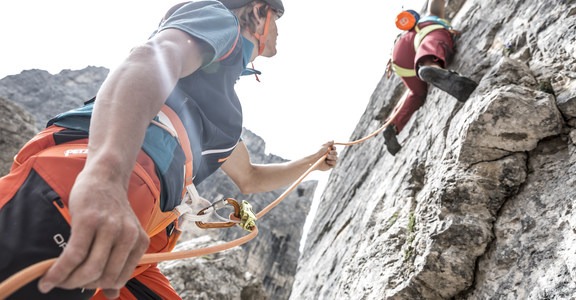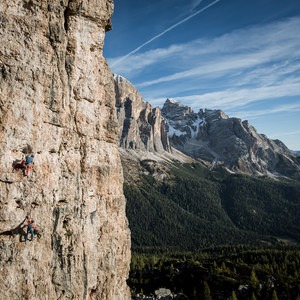First response techniques in alpine terrain
If an accident occurs in alpine terrain, injuries can range from small scrapes through to heavy bleeding, broken bones or loss of consciousness. If necessary, the rope partner may need to perform first aid and must be able to perform the necessary techniques – this is the only way to help the injured person quickly.
Heavy bleeding and a state of shock
If there is heavy bleeding, the number one priority is to stem it. To this end, the first responder applies a pressure bandage. The responder wears gloves to protect themselves and the injured person from infections and prevent dirt getting into the wound.
Pressure bandage
- Place a sterile dressing on the wound.
- Secure the dressing by winding a gauze bandage around it twice.
- Use a wrapped gauze bandage or a wrapped first-aid packet as a pressure pad and place it directly onto the wound’s sterile dressing.
- Fix the pressure pad in place with the remaining gauze bandage.
- Tie a bow or a knot around the pressure pad.
- Check: If toes/fingers start to tingle, the pressure bandage is too tight and needs to be loosened carefully.
Checking vital functions using the ABC techniques
The ABC is a model that can be used to quickly treat heart and circulatory issues.
- AIRWAY -Turn the person on their back. An intensive mouth check is no longer included as part of first aid. However: If it is apparent that the airways are blocked by foreign bodies, these should be removed.
- BREATHING - You should regularly check the person is breathing. See: Is the ribcage moving? Hear: Can the first responder hear the person breathing? Feel: Can the first responder feel a warm airflow coming from the accident victim’s mouth or nose? If they are not breathing, are breathing infrequently or are gasping for air, you must begin resuscitating.
- CIRCULATION - If the accident victim is breathing normally, there is proper circulation. If they are not breathing normally, there is no circulation.
ATTENTION: Any bleeding must be stopped immediately and is the number one priority! If, as well as being unconscious, the accident victim also stops breathing normally, the first responder must start resuscitating immediately.
RESUSCITATION
If you cannot tell if the unconscious person is breathing normally, you must immediately make an emergency call. This is immediately followed by cardiopulmonary resuscitation to ensure the brain is supplied with oxygen. Cardiopulmonary resuscitation refers to a combination of chest compressions and mouth-to-mouth/nose in a ratio of 30 to 2.
CHEST COMPRESSIONS
- Kneel next to the lifeless person in line with their ribcage.
- Place the heel of one hand on the center of the ribcage. Place your other hand on top of it and link your fingers. Keep your arms straight.
- Use your own body weight to push the lifeless person’s chest down five to six centimeters. Apply pressure firmly and quickly!
- Completely remove pressure from the ribcage after every chest compression.
After 30 chest compressions, give mouth-to-mouth/nose twice: Close the nose with one hand while placing the other on the person’s chin and tilting their head backward. Breathe in normally and then place your lips around the accident victim’s mouth and breathe out normally.
Perform chest compressions and mouth-to-mouth/nose in a ratio of 30:2 until professional help (mountain rescue / emergency doctor) has arrived or you are exhausted.
STABLE RECOVERY POSITION
If the accident victim is unconscious but is breathing normally, they are to be put in the stable recovery position. The stable recovery position ensures that airways remain open and vomit or blood can flow out. The accident victim is thereby protected from choking.
NOTE: Any loss of consciousness is an indication of a serious health disorder and is therefore life-threatening. You must make an emergency call without delay!
Procedure for recovery position:
- Kneel down on the downhill side of the unconscious person.
- Lay their near-side arm at a 90-degree angle next to them.
- Bend their far-side leg and hold in place.
- Hold their far-side hand, lay the back of the hand on their cheek (the one facing towards you) and hold in place.
- Turn the injured person toward you at the knee.
- Carefully pull your own hand out from under the injured person’s head so that they are lying only on the back of their hand.
- Tilt their head backward.
- Open their mouth slightly. The mouth should be slightly lower than their stomach, so that blood or vomit can run out.
Even in the stable recovery position, breathing must be checked constantly. Breathing can stop at any time.
Check out the full series of Safety Academy Lab Rock videos below:
- Alpine basics
- Basic equipment for every climber
- Basic equipment for groups
- Additional equipment for groups
- Storms in the mountains
- Types of rock in the Alps
- Tour planning for alpine climbing
- Packing a backpack correctly
- Rope team procedures
- Knot techniques
- Belay using bolts
- Belay methods
- Anchors
- Coiling a climbing rope
- Rappelling
- What to do in an alpine emergency
- First aid on the mountain
- Rescue techniques while alpine climbing
- Bivouacking in an emergency situation
Visit ORTOVOX’s Safety Academy Lab Rock to view the climbing tutorials in their totality and test your knowledge with their fun and interactive quizzes.
Since the company was founded in 1980 in the south of Munich, ORTOVOX has stood for the highest possible protection during alpine activities. As pioneers in the avalanche safety field, we have played a key role in the development of emergency equipment for the mountains. Innovations such as the double-frequency avalanche transceiver and Smart Antenna Technology, and also targeted training measures, continue to be valuable contributions to making mountain sports a little bit safer and to saving lives.






Comments
Sign In and share them.